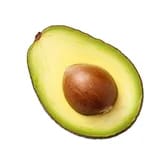10 minutesPrep time
585 cal.Per serving
Ingredients
recipe

Step 1
Rehydrate or cook the rice noodles according to package instructions. Once ready, drain the noodles & run them under cold water. Set aside.

Step 2
Meanwhile, wash & remove the base of the red cabbage. Very finely slice the red cabbage.

Step 3
Peel & grate the carrots.

Step 4
Rinse & finely mince the mint.

Step 5
Cut the avocado in half. Remove the skin, then cut into thin slices.



Step 6
Meanwhile, prepare the peanut sauce. In a bowl, mix : the soy sauce, peanut butter & sesame oil.* Add a drizzle of water little by little, to thin-out the sauce, until desired consistency. *Check out our tips for this step
Step 7
Serve the rice noodles in a bowl or shallow dish with the carrots, red cabbage & avocado. Add the mint & generously lather in sauce & stir to combine. Enjoy !

For a truly flavoursome dish, we suggest adding minced garlic & ginger to the sauce.
- Domitille, Food Editor
Personal notes
Add your own flavor!
Nutrition facts
Average estimated amount for one serving
| Energy | 585 cal. |
| Fat | 31 g |
| Carbohydrates | 62 g |
| Protein | 10 g |
| Fiber | 10 g |
Values are based on an average estimate for one serving. All nutrition information presented on Jow is intended for informational purposes only. If you have any concerns or questions about your health, please consult with a health-care professional.
On average, one serving of the recipe "Thaï Salad" contains 585 Energy, 31 g of Fat, 62 g of Carbohydrates, 10 g of Protein, 10 g of Fiber.
Price per portion
| € | Nos recettes à -2 € par portion |
| €€ | Nos recettes entre 2 € et 4 € par portion |
| €€€ | Nos recettes à +4 € par portion |
Please note, the price above is dependent on your grocer and the available products in the grocery store you chose.
Scores


B Nutri-score
The Nutri-score is an indicator intended for understanding nutritional information. Recipes or products are classified from A to E according to their food composition to promote (fiber, proteins, fruits, vegetables, legumes, etc.) and foods to limit (energy, saturated fatty acids, sugars, salt, etc.).
A+ Green-score
The Green-score is an indicator representing the environmental impact of food products. The recipes or products are classified from A+ to F. It takes into account several factors on the pollution of air, water, oceans, soil, as well as the impacts on the biosphere. These impacts are studied throughout the product life cycle.
Retrieving reviews...



